Total Quality Management Analysis for Event Management: Banks Sadler
VerifiedAdded on 2021/04/19
|13
|2844
|114
Report
AI Summary
This report provides a comprehensive analysis of Total Quality Management (TQM) within the event management sector, focusing on the case of Banks Sadler. The study begins with an introduction to TQM, defining its core principles and significance. An overview of Banks Sadler's operations and history sets the context for the analysis. The report delves into the historical development of TQM, highlighting key quality gurus and their contributions. It then explores the application of specific TQM tools, including Quality Circles and Benchmarking, detailing their features, limitations, and implementation strategies within Banks Sadler. The report uses practical examples and case studies to illustrate how these tools can be applied to improve performance and address challenges in the event management industry, such as time management and service quality. Finally, the report concludes with recommendations for Banks Sadler, based on the identified strengths and weaknesses, providing a roadmap for continuous improvement in event management practices.

Events Sector |
Banks Sadler Total Quality Management
Banks Sadler Total Quality Management
Paraphrase This Document
Need a fresh take? Get an instant paraphrase of this document with our AI Paraphraser
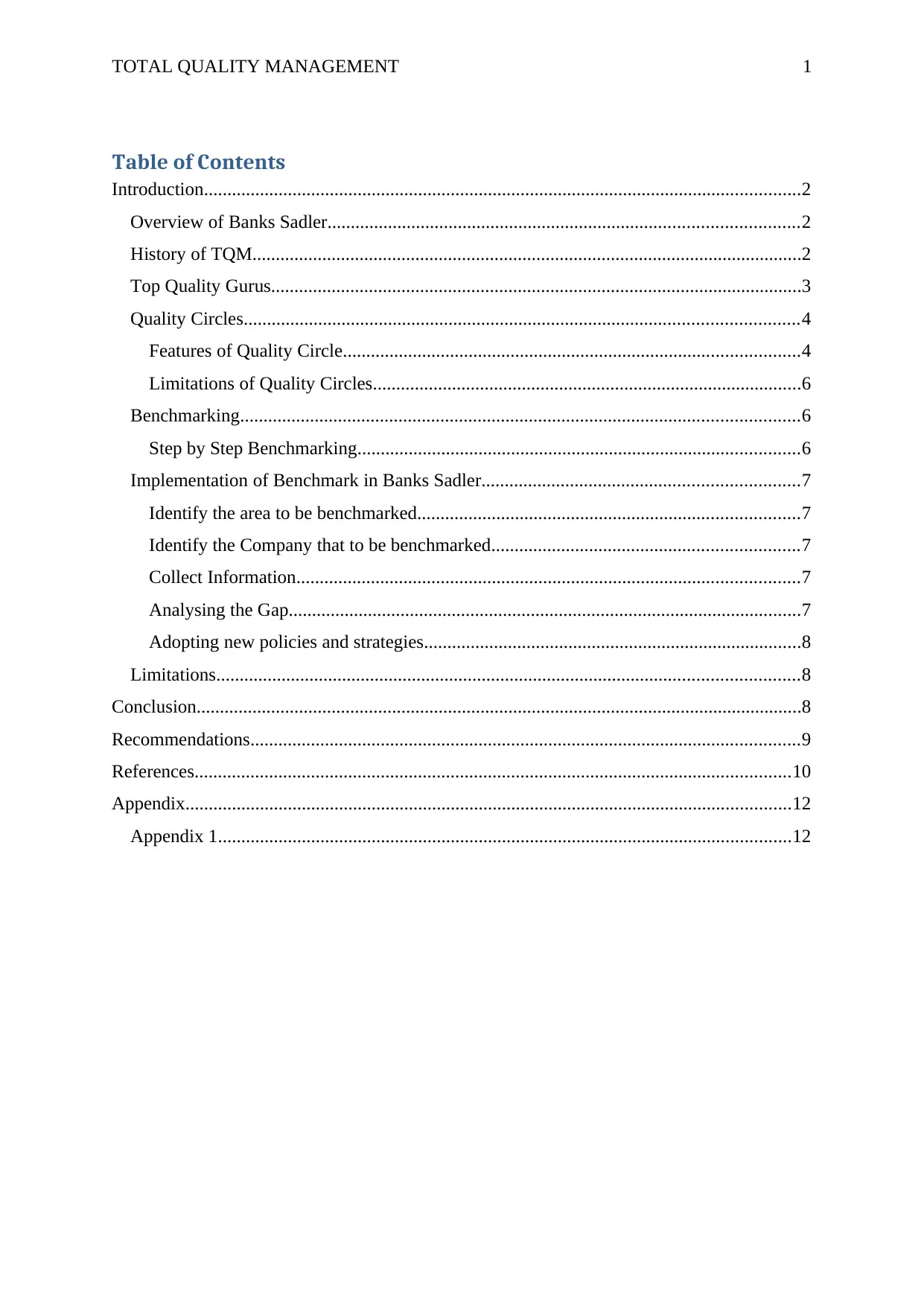
TOTAL QUALITY MANAGEMENT 1
Table of Contents
Introduction................................................................................................................................2
Overview of Banks Sadler.....................................................................................................2
History of TQM......................................................................................................................2
Top Quality Gurus..................................................................................................................3
Quality Circles.......................................................................................................................4
Features of Quality Circle..................................................................................................4
Limitations of Quality Circles............................................................................................6
Benchmarking........................................................................................................................6
Step by Step Benchmarking...............................................................................................6
Implementation of Benchmark in Banks Sadler....................................................................7
Identify the area to be benchmarked..................................................................................7
Identify the Company that to be benchmarked..................................................................7
Collect Information............................................................................................................7
Analysing the Gap..............................................................................................................7
Adopting new policies and strategies.................................................................................8
Limitations.............................................................................................................................8
Conclusion..................................................................................................................................8
Recommendations......................................................................................................................9
References................................................................................................................................10
Appendix..................................................................................................................................12
Appendix 1...........................................................................................................................12
Table of Contents
Introduction................................................................................................................................2
Overview of Banks Sadler.....................................................................................................2
History of TQM......................................................................................................................2
Top Quality Gurus..................................................................................................................3
Quality Circles.......................................................................................................................4
Features of Quality Circle..................................................................................................4
Limitations of Quality Circles............................................................................................6
Benchmarking........................................................................................................................6
Step by Step Benchmarking...............................................................................................6
Implementation of Benchmark in Banks Sadler....................................................................7
Identify the area to be benchmarked..................................................................................7
Identify the Company that to be benchmarked..................................................................7
Collect Information............................................................................................................7
Analysing the Gap..............................................................................................................7
Adopting new policies and strategies.................................................................................8
Limitations.............................................................................................................................8
Conclusion..................................................................................................................................8
Recommendations......................................................................................................................9
References................................................................................................................................10
Appendix..................................................................................................................................12
Appendix 1...........................................................................................................................12
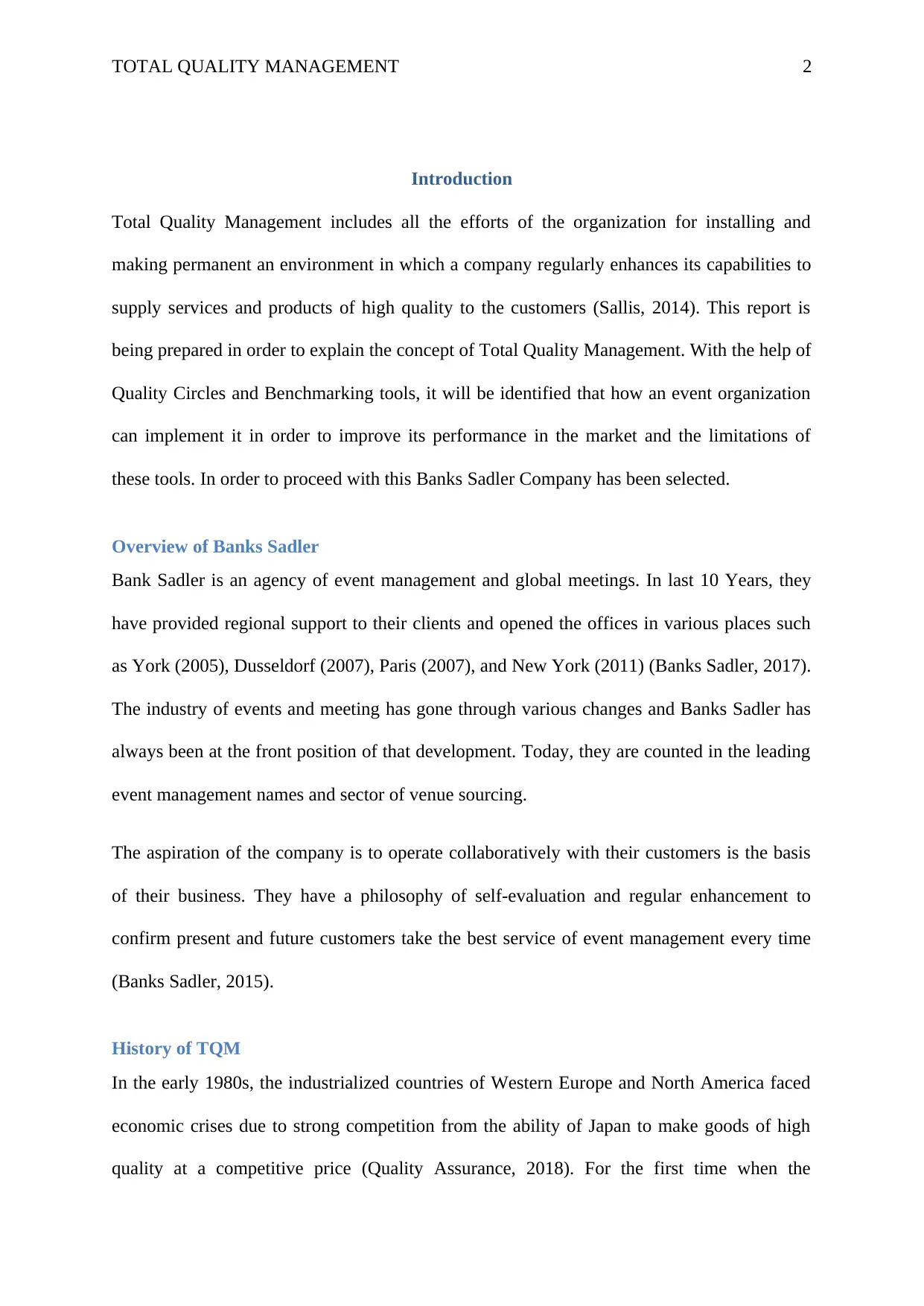
TOTAL QUALITY MANAGEMENT 2
Introduction
Total Quality Management includes all the efforts of the organization for installing and
making permanent an environment in which a company regularly enhances its capabilities to
supply services and products of high quality to the customers (Sallis, 2014). This report is
being prepared in order to explain the concept of Total Quality Management. With the help of
Quality Circles and Benchmarking tools, it will be identified that how an event organization
can implement it in order to improve its performance in the market and the limitations of
these tools. In order to proceed with this Banks Sadler Company has been selected.
Overview of Banks Sadler
Bank Sadler is an agency of event management and global meetings. In last 10 Years, they
have provided regional support to their clients and opened the offices in various places such
as York (2005), Dusseldorf (2007), Paris (2007), and New York (2011) (Banks Sadler, 2017).
The industry of events and meeting has gone through various changes and Banks Sadler has
always been at the front position of that development. Today, they are counted in the leading
event management names and sector of venue sourcing.
The aspiration of the company is to operate collaboratively with their customers is the basis
of their business. They have a philosophy of self-evaluation and regular enhancement to
confirm present and future customers take the best service of event management every time
(Banks Sadler, 2015).
History of TQM
In the early 1980s, the industrialized countries of Western Europe and North America faced
economic crises due to strong competition from the ability of Japan to make goods of high
quality at a competitive price (Quality Assurance, 2018). For the first time when the
Introduction
Total Quality Management includes all the efforts of the organization for installing and
making permanent an environment in which a company regularly enhances its capabilities to
supply services and products of high quality to the customers (Sallis, 2014). This report is
being prepared in order to explain the concept of Total Quality Management. With the help of
Quality Circles and Benchmarking tools, it will be identified that how an event organization
can implement it in order to improve its performance in the market and the limitations of
these tools. In order to proceed with this Banks Sadler Company has been selected.
Overview of Banks Sadler
Bank Sadler is an agency of event management and global meetings. In last 10 Years, they
have provided regional support to their clients and opened the offices in various places such
as York (2005), Dusseldorf (2007), Paris (2007), and New York (2011) (Banks Sadler, 2017).
The industry of events and meeting has gone through various changes and Banks Sadler has
always been at the front position of that development. Today, they are counted in the leading
event management names and sector of venue sourcing.
The aspiration of the company is to operate collaboratively with their customers is the basis
of their business. They have a philosophy of self-evaluation and regular enhancement to
confirm present and future customers take the best service of event management every time
(Banks Sadler, 2015).
History of TQM
In the early 1980s, the industrialized countries of Western Europe and North America faced
economic crises due to strong competition from the ability of Japan to make goods of high
quality at a competitive price (Quality Assurance, 2018). For the first time when the
⊘ This is a preview!⊘
Do you want full access?
Subscribe today to unlock all pages.

Trusted by 1+ million students worldwide
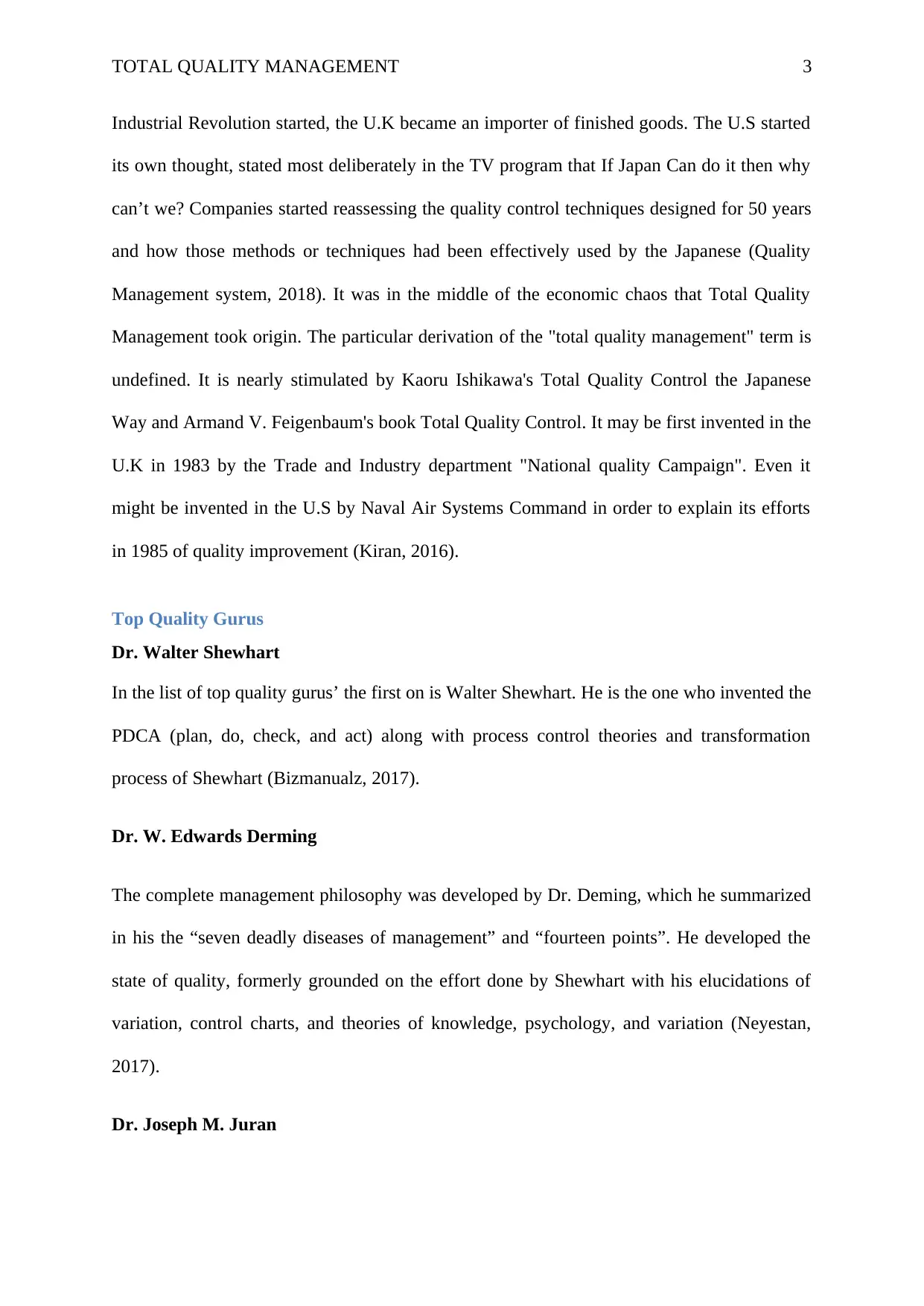
TOTAL QUALITY MANAGEMENT 3
Industrial Revolution started, the U.K became an importer of finished goods. The U.S started
its own thought, stated most deliberately in the TV program that If Japan Can do it then why
can’t we? Companies started reassessing the quality control techniques designed for 50 years
and how those methods or techniques had been effectively used by the Japanese (Quality
Management system, 2018). It was in the middle of the economic chaos that Total Quality
Management took origin. The particular derivation of the "total quality management" term is
undefined. It is nearly stimulated by Kaoru Ishikawa's Total Quality Control the Japanese
Way and Armand V. Feigenbaum's book Total Quality Control. It may be first invented in the
U.K in 1983 by the Trade and Industry department "National quality Campaign". Even it
might be invented in the U.S by Naval Air Systems Command in order to explain its efforts
in 1985 of quality improvement (Kiran, 2016).
Top Quality Gurus
Dr. Walter Shewhart
In the list of top quality gurus’ the first on is Walter Shewhart. He is the one who invented the
PDCA (plan, do, check, and act) along with process control theories and transformation
process of Shewhart (Bizmanualz, 2017).
Dr. W. Edwards Derming
The complete management philosophy was developed by Dr. Deming, which he summarized
in his the “seven deadly diseases of management” and “fourteen points”. He developed the
state of quality, formerly grounded on the effort done by Shewhart with his elucidations of
variation, control charts, and theories of knowledge, psychology, and variation (Neyestan,
2017).
Dr. Joseph M. Juran
Industrial Revolution started, the U.K became an importer of finished goods. The U.S started
its own thought, stated most deliberately in the TV program that If Japan Can do it then why
can’t we? Companies started reassessing the quality control techniques designed for 50 years
and how those methods or techniques had been effectively used by the Japanese (Quality
Management system, 2018). It was in the middle of the economic chaos that Total Quality
Management took origin. The particular derivation of the "total quality management" term is
undefined. It is nearly stimulated by Kaoru Ishikawa's Total Quality Control the Japanese
Way and Armand V. Feigenbaum's book Total Quality Control. It may be first invented in the
U.K in 1983 by the Trade and Industry department "National quality Campaign". Even it
might be invented in the U.S by Naval Air Systems Command in order to explain its efforts
in 1985 of quality improvement (Kiran, 2016).
Top Quality Gurus
Dr. Walter Shewhart
In the list of top quality gurus’ the first on is Walter Shewhart. He is the one who invented the
PDCA (plan, do, check, and act) along with process control theories and transformation
process of Shewhart (Bizmanualz, 2017).
Dr. W. Edwards Derming
The complete management philosophy was developed by Dr. Deming, which he summarized
in his the “seven deadly diseases of management” and “fourteen points”. He developed the
state of quality, formerly grounded on the effort done by Shewhart with his elucidations of
variation, control charts, and theories of knowledge, psychology, and variation (Neyestan,
2017).
Dr. Joseph M. Juran
Paraphrase This Document
Need a fresh take? Get an instant paraphrase of this document with our AI Paraphraser
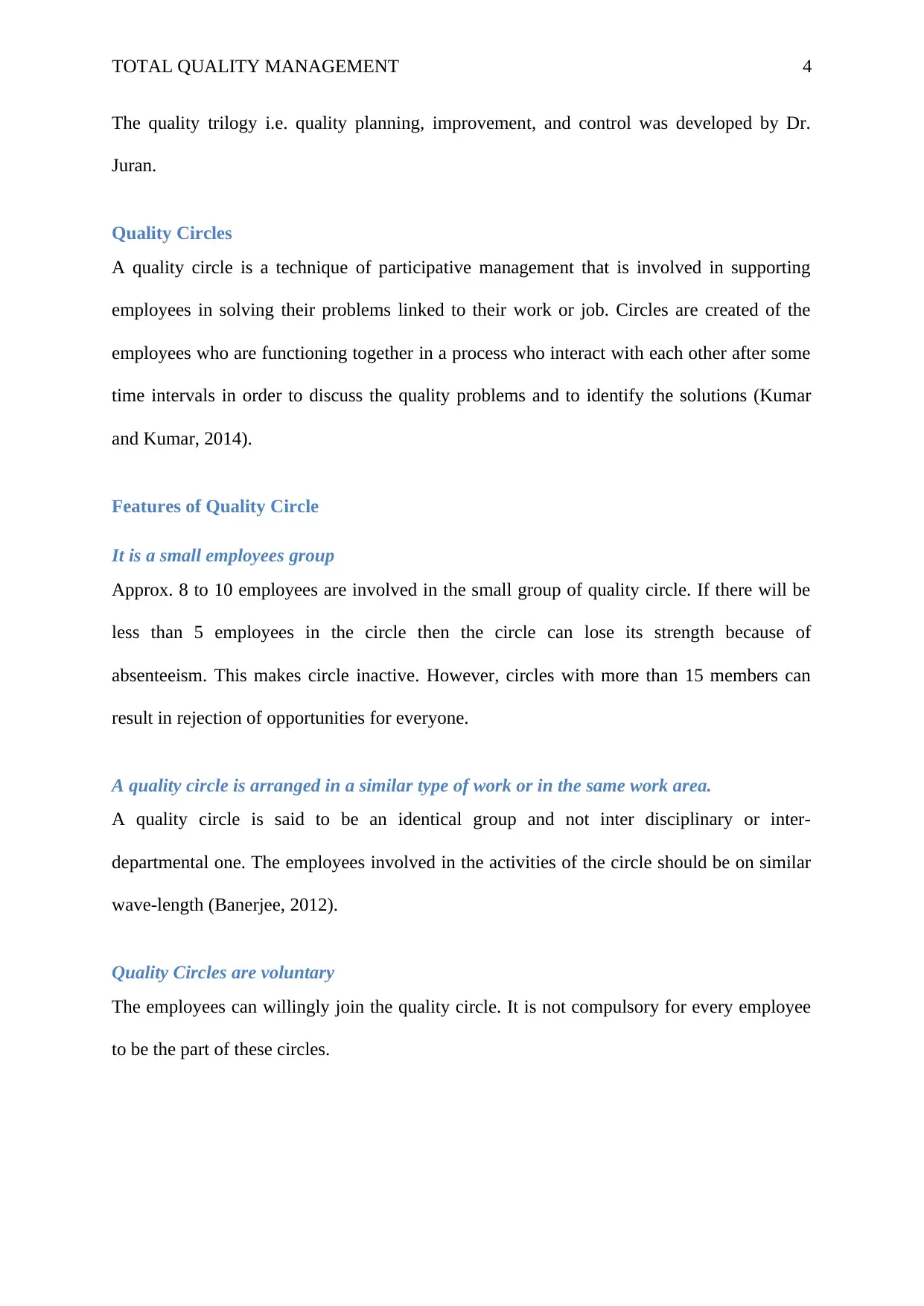
TOTAL QUALITY MANAGEMENT 4
The quality trilogy i.e. quality planning, improvement, and control was developed by Dr.
Juran.
Quality Circles
A quality circle is a technique of participative management that is involved in supporting
employees in solving their problems linked to their work or job. Circles are created of the
employees who are functioning together in a process who interact with each other after some
time intervals in order to discuss the quality problems and to identify the solutions (Kumar
and Kumar, 2014).
Features of Quality Circle
It is a small employees group
Approx. 8 to 10 employees are involved in the small group of quality circle. If there will be
less than 5 employees in the circle then the circle can lose its strength because of
absenteeism. This makes circle inactive. However, circles with more than 15 members can
result in rejection of opportunities for everyone.
A quality circle is arranged in a similar type of work or in the same work area.
A quality circle is said to be an identical group and not inter disciplinary or inter-
departmental one. The employees involved in the activities of the circle should be on similar
wave-length (Banerjee, 2012).
Quality Circles are voluntary
The employees can willingly join the quality circle. It is not compulsory for every employee
to be the part of these circles.
The quality trilogy i.e. quality planning, improvement, and control was developed by Dr.
Juran.
Quality Circles
A quality circle is a technique of participative management that is involved in supporting
employees in solving their problems linked to their work or job. Circles are created of the
employees who are functioning together in a process who interact with each other after some
time intervals in order to discuss the quality problems and to identify the solutions (Kumar
and Kumar, 2014).
Features of Quality Circle
It is a small employees group
Approx. 8 to 10 employees are involved in the small group of quality circle. If there will be
less than 5 employees in the circle then the circle can lose its strength because of
absenteeism. This makes circle inactive. However, circles with more than 15 members can
result in rejection of opportunities for everyone.
A quality circle is arranged in a similar type of work or in the same work area.
A quality circle is said to be an identical group and not inter disciplinary or inter-
departmental one. The employees involved in the activities of the circle should be on similar
wave-length (Banerjee, 2012).
Quality Circles are voluntary
The employees can willingly join the quality circle. It is not compulsory for every employee
to be the part of these circles.
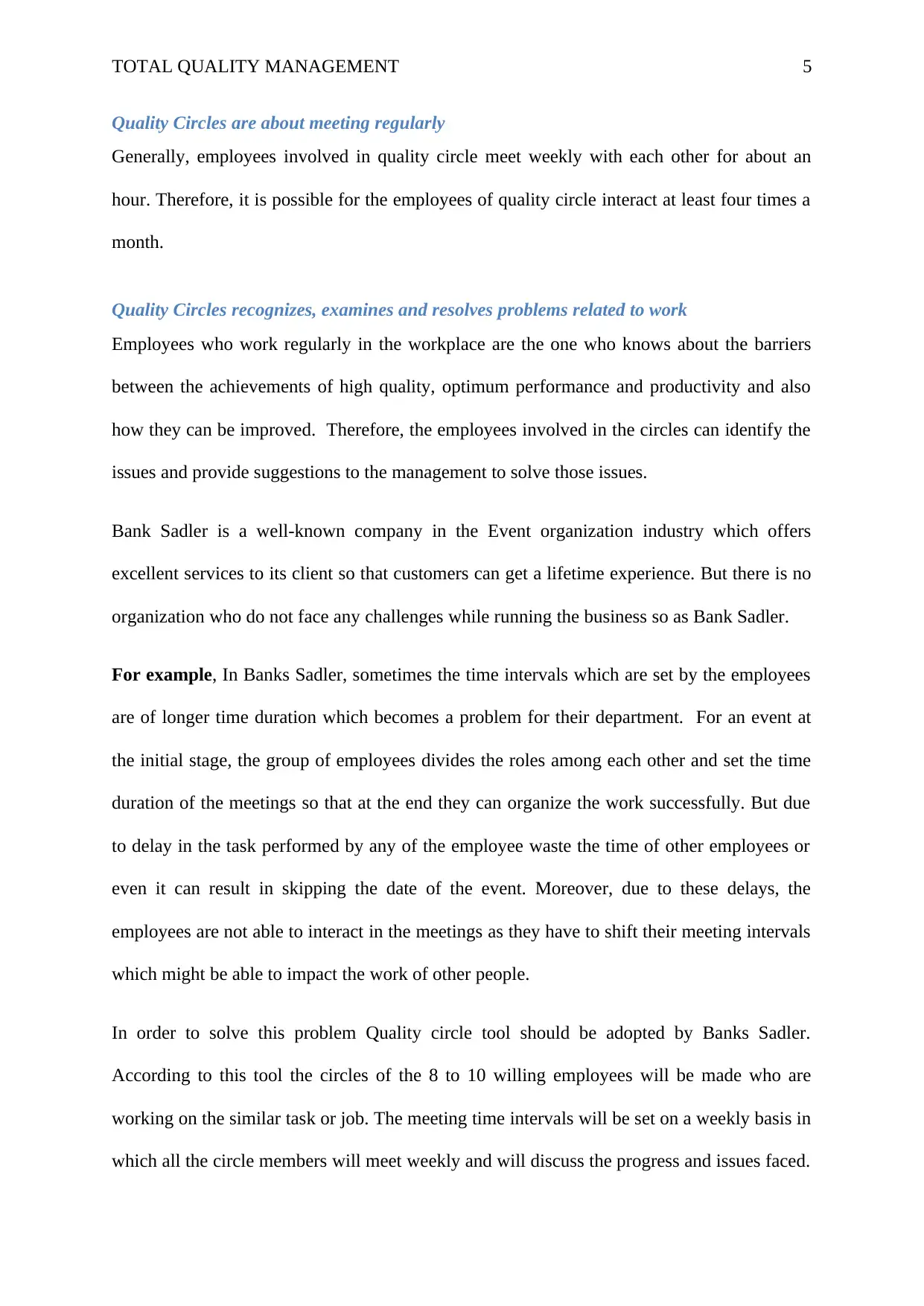
TOTAL QUALITY MANAGEMENT 5
Quality Circles are about meeting regularly
Generally, employees involved in quality circle meet weekly with each other for about an
hour. Therefore, it is possible for the employees of quality circle interact at least four times a
month.
Quality Circles recognizes, examines and resolves problems related to work
Employees who work regularly in the workplace are the one who knows about the barriers
between the achievements of high quality, optimum performance and productivity and also
how they can be improved. Therefore, the employees involved in the circles can identify the
issues and provide suggestions to the management to solve those issues.
Bank Sadler is a well-known company in the Event organization industry which offers
excellent services to its client so that customers can get a lifetime experience. But there is no
organization who do not face any challenges while running the business so as Bank Sadler.
For example, In Banks Sadler, sometimes the time intervals which are set by the employees
are of longer time duration which becomes a problem for their department. For an event at
the initial stage, the group of employees divides the roles among each other and set the time
duration of the meetings so that at the end they can organize the work successfully. But due
to delay in the task performed by any of the employee waste the time of other employees or
even it can result in skipping the date of the event. Moreover, due to these delays, the
employees are not able to interact in the meetings as they have to shift their meeting intervals
which might be able to impact the work of other people.
In order to solve this problem Quality circle tool should be adopted by Banks Sadler.
According to this tool the circles of the 8 to 10 willing employees will be made who are
working on the similar task or job. The meeting time intervals will be set on a weekly basis in
which all the circle members will meet weekly and will discuss the progress and issues faced.
Quality Circles are about meeting regularly
Generally, employees involved in quality circle meet weekly with each other for about an
hour. Therefore, it is possible for the employees of quality circle interact at least four times a
month.
Quality Circles recognizes, examines and resolves problems related to work
Employees who work regularly in the workplace are the one who knows about the barriers
between the achievements of high quality, optimum performance and productivity and also
how they can be improved. Therefore, the employees involved in the circles can identify the
issues and provide suggestions to the management to solve those issues.
Bank Sadler is a well-known company in the Event organization industry which offers
excellent services to its client so that customers can get a lifetime experience. But there is no
organization who do not face any challenges while running the business so as Bank Sadler.
For example, In Banks Sadler, sometimes the time intervals which are set by the employees
are of longer time duration which becomes a problem for their department. For an event at
the initial stage, the group of employees divides the roles among each other and set the time
duration of the meetings so that at the end they can organize the work successfully. But due
to delay in the task performed by any of the employee waste the time of other employees or
even it can result in skipping the date of the event. Moreover, due to these delays, the
employees are not able to interact in the meetings as they have to shift their meeting intervals
which might be able to impact the work of other people.
In order to solve this problem Quality circle tool should be adopted by Banks Sadler.
According to this tool the circles of the 8 to 10 willing employees will be made who are
working on the similar task or job. The meeting time intervals will be set on a weekly basis in
which all the circle members will meet weekly and will discuss the progress and issues faced.
⊘ This is a preview!⊘
Do you want full access?
Subscribe today to unlock all pages.

Trusted by 1+ million students worldwide
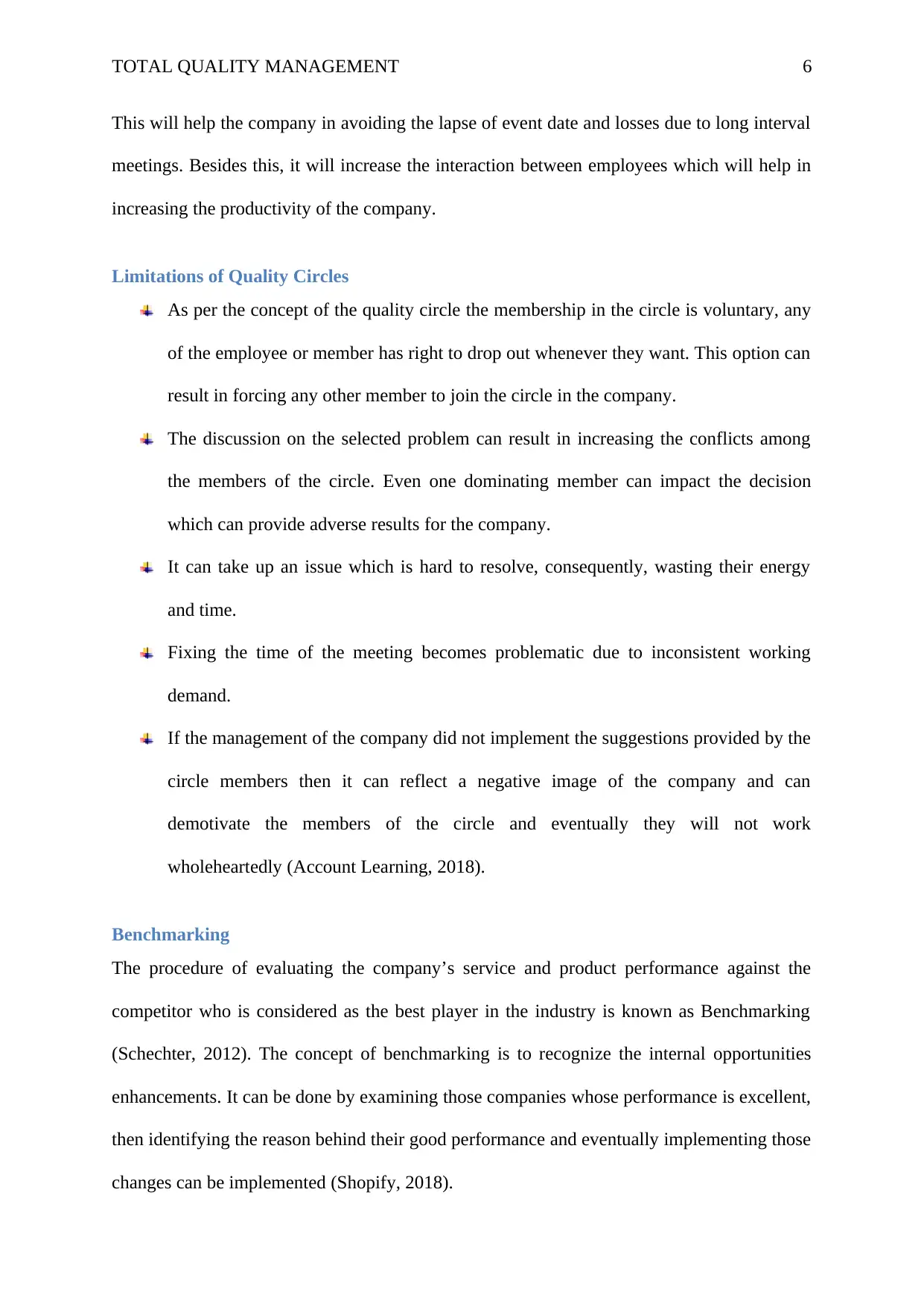
TOTAL QUALITY MANAGEMENT 6
This will help the company in avoiding the lapse of event date and losses due to long interval
meetings. Besides this, it will increase the interaction between employees which will help in
increasing the productivity of the company.
Limitations of Quality Circles
As per the concept of the quality circle the membership in the circle is voluntary, any
of the employee or member has right to drop out whenever they want. This option can
result in forcing any other member to join the circle in the company.
The discussion on the selected problem can result in increasing the conflicts among
the members of the circle. Even one dominating member can impact the decision
which can provide adverse results for the company.
It can take up an issue which is hard to resolve, consequently, wasting their energy
and time.
Fixing the time of the meeting becomes problematic due to inconsistent working
demand.
If the management of the company did not implement the suggestions provided by the
circle members then it can reflect a negative image of the company and can
demotivate the members of the circle and eventually they will not work
wholeheartedly (Account Learning, 2018).
Benchmarking
The procedure of evaluating the company’s service and product performance against the
competitor who is considered as the best player in the industry is known as Benchmarking
(Schechter, 2012). The concept of benchmarking is to recognize the internal opportunities
enhancements. It can be done by examining those companies whose performance is excellent,
then identifying the reason behind their good performance and eventually implementing those
changes can be implemented (Shopify, 2018).
This will help the company in avoiding the lapse of event date and losses due to long interval
meetings. Besides this, it will increase the interaction between employees which will help in
increasing the productivity of the company.
Limitations of Quality Circles
As per the concept of the quality circle the membership in the circle is voluntary, any
of the employee or member has right to drop out whenever they want. This option can
result in forcing any other member to join the circle in the company.
The discussion on the selected problem can result in increasing the conflicts among
the members of the circle. Even one dominating member can impact the decision
which can provide adverse results for the company.
It can take up an issue which is hard to resolve, consequently, wasting their energy
and time.
Fixing the time of the meeting becomes problematic due to inconsistent working
demand.
If the management of the company did not implement the suggestions provided by the
circle members then it can reflect a negative image of the company and can
demotivate the members of the circle and eventually they will not work
wholeheartedly (Account Learning, 2018).
Benchmarking
The procedure of evaluating the company’s service and product performance against the
competitor who is considered as the best player in the industry is known as Benchmarking
(Schechter, 2012). The concept of benchmarking is to recognize the internal opportunities
enhancements. It can be done by examining those companies whose performance is excellent,
then identifying the reason behind their good performance and eventually implementing those
changes can be implemented (Shopify, 2018).
Paraphrase This Document
Need a fresh take? Get an instant paraphrase of this document with our AI Paraphraser
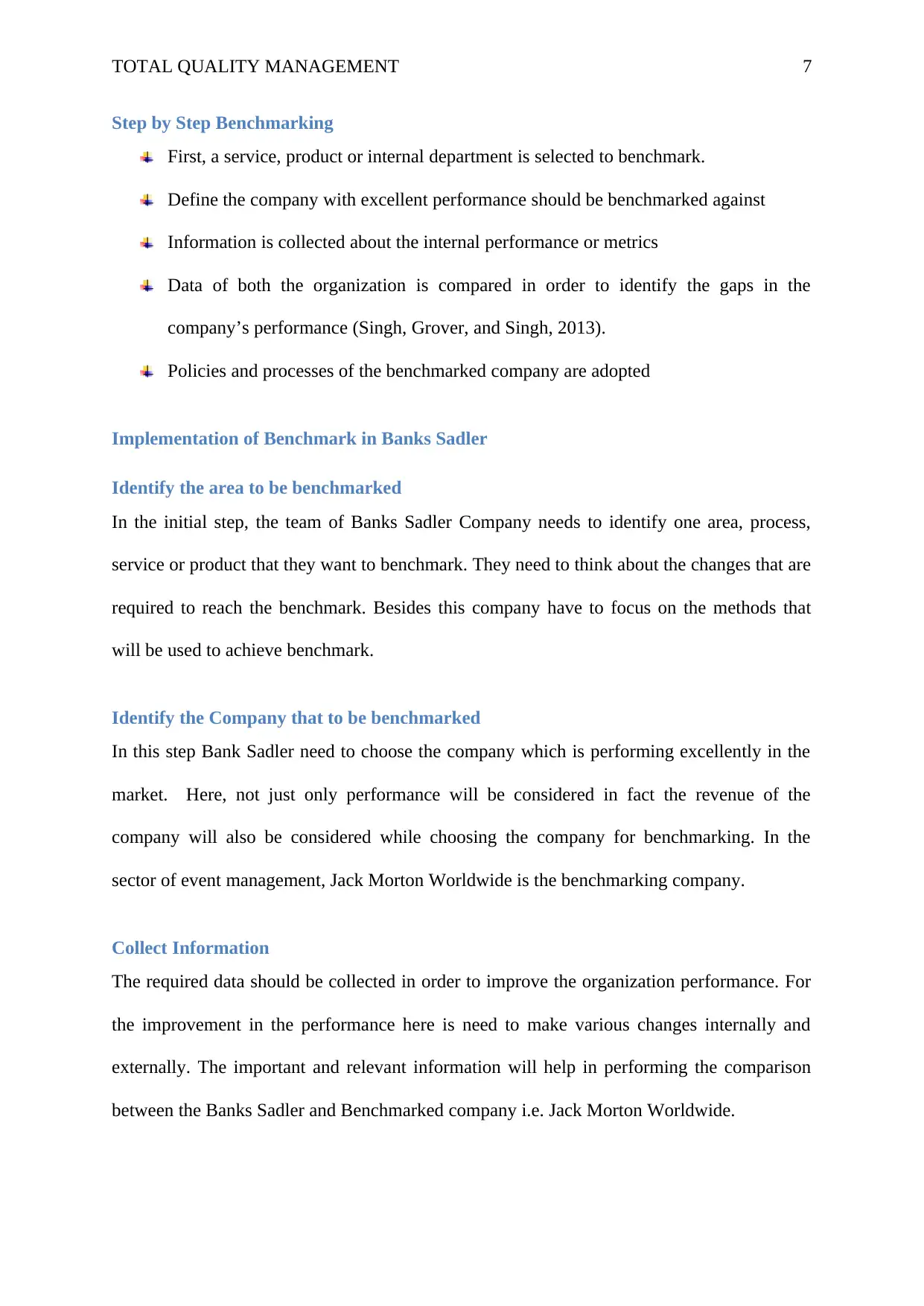
TOTAL QUALITY MANAGEMENT 7
Step by Step Benchmarking
First, a service, product or internal department is selected to benchmark.
Define the company with excellent performance should be benchmarked against
Information is collected about the internal performance or metrics
Data of both the organization is compared in order to identify the gaps in the
company’s performance (Singh, Grover, and Singh, 2013).
Policies and processes of the benchmarked company are adopted
Implementation of Benchmark in Banks Sadler
Identify the area to be benchmarked
In the initial step, the team of Banks Sadler Company needs to identify one area, process,
service or product that they want to benchmark. They need to think about the changes that are
required to reach the benchmark. Besides this company have to focus on the methods that
will be used to achieve benchmark.
Identify the Company that to be benchmarked
In this step Bank Sadler need to choose the company which is performing excellently in the
market. Here, not just only performance will be considered in fact the revenue of the
company will also be considered while choosing the company for benchmarking. In the
sector of event management, Jack Morton Worldwide is the benchmarking company.
Collect Information
The required data should be collected in order to improve the organization performance. For
the improvement in the performance here is need to make various changes internally and
externally. The important and relevant information will help in performing the comparison
between the Banks Sadler and Benchmarked company i.e. Jack Morton Worldwide.
Step by Step Benchmarking
First, a service, product or internal department is selected to benchmark.
Define the company with excellent performance should be benchmarked against
Information is collected about the internal performance or metrics
Data of both the organization is compared in order to identify the gaps in the
company’s performance (Singh, Grover, and Singh, 2013).
Policies and processes of the benchmarked company are adopted
Implementation of Benchmark in Banks Sadler
Identify the area to be benchmarked
In the initial step, the team of Banks Sadler Company needs to identify one area, process,
service or product that they want to benchmark. They need to think about the changes that are
required to reach the benchmark. Besides this company have to focus on the methods that
will be used to achieve benchmark.
Identify the Company that to be benchmarked
In this step Bank Sadler need to choose the company which is performing excellently in the
market. Here, not just only performance will be considered in fact the revenue of the
company will also be considered while choosing the company for benchmarking. In the
sector of event management, Jack Morton Worldwide is the benchmarking company.
Collect Information
The required data should be collected in order to improve the organization performance. For
the improvement in the performance here is need to make various changes internally and
externally. The important and relevant information will help in performing the comparison
between the Banks Sadler and Benchmarked company i.e. Jack Morton Worldwide.
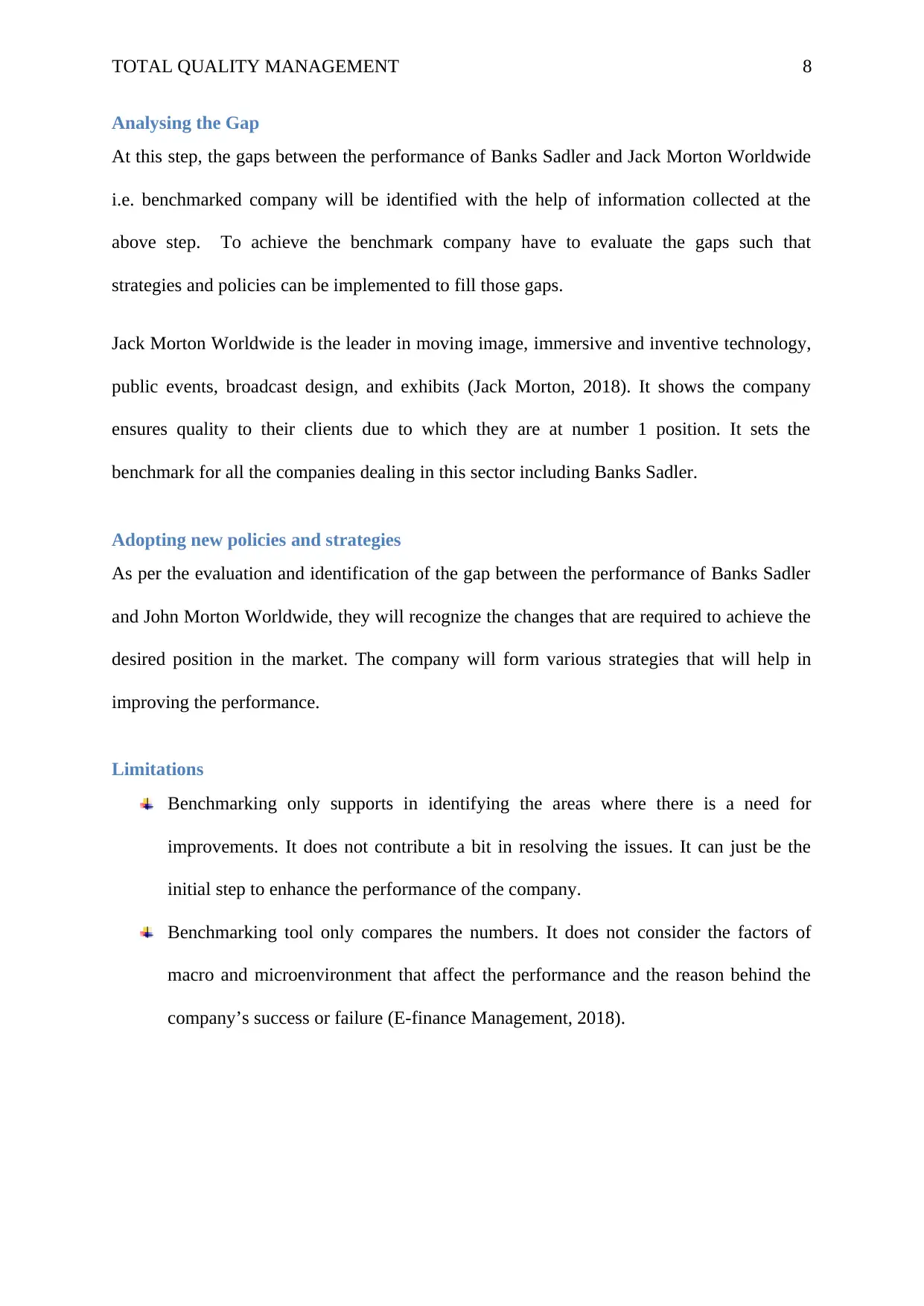
TOTAL QUALITY MANAGEMENT 8
Analysing the Gap
At this step, the gaps between the performance of Banks Sadler and Jack Morton Worldwide
i.e. benchmarked company will be identified with the help of information collected at the
above step. To achieve the benchmark company have to evaluate the gaps such that
strategies and policies can be implemented to fill those gaps.
Jack Morton Worldwide is the leader in moving image, immersive and inventive technology,
public events, broadcast design, and exhibits (Jack Morton, 2018). It shows the company
ensures quality to their clients due to which they are at number 1 position. It sets the
benchmark for all the companies dealing in this sector including Banks Sadler.
Adopting new policies and strategies
As per the evaluation and identification of the gap between the performance of Banks Sadler
and John Morton Worldwide, they will recognize the changes that are required to achieve the
desired position in the market. The company will form various strategies that will help in
improving the performance.
Limitations
Benchmarking only supports in identifying the areas where there is a need for
improvements. It does not contribute a bit in resolving the issues. It can just be the
initial step to enhance the performance of the company.
Benchmarking tool only compares the numbers. It does not consider the factors of
macro and microenvironment that affect the performance and the reason behind the
company’s success or failure (E-finance Management, 2018).
Analysing the Gap
At this step, the gaps between the performance of Banks Sadler and Jack Morton Worldwide
i.e. benchmarked company will be identified with the help of information collected at the
above step. To achieve the benchmark company have to evaluate the gaps such that
strategies and policies can be implemented to fill those gaps.
Jack Morton Worldwide is the leader in moving image, immersive and inventive technology,
public events, broadcast design, and exhibits (Jack Morton, 2018). It shows the company
ensures quality to their clients due to which they are at number 1 position. It sets the
benchmark for all the companies dealing in this sector including Banks Sadler.
Adopting new policies and strategies
As per the evaluation and identification of the gap between the performance of Banks Sadler
and John Morton Worldwide, they will recognize the changes that are required to achieve the
desired position in the market. The company will form various strategies that will help in
improving the performance.
Limitations
Benchmarking only supports in identifying the areas where there is a need for
improvements. It does not contribute a bit in resolving the issues. It can just be the
initial step to enhance the performance of the company.
Benchmarking tool only compares the numbers. It does not consider the factors of
macro and microenvironment that affect the performance and the reason behind the
company’s success or failure (E-finance Management, 2018).
⊘ This is a preview!⊘
Do you want full access?
Subscribe today to unlock all pages.

Trusted by 1+ million students worldwide
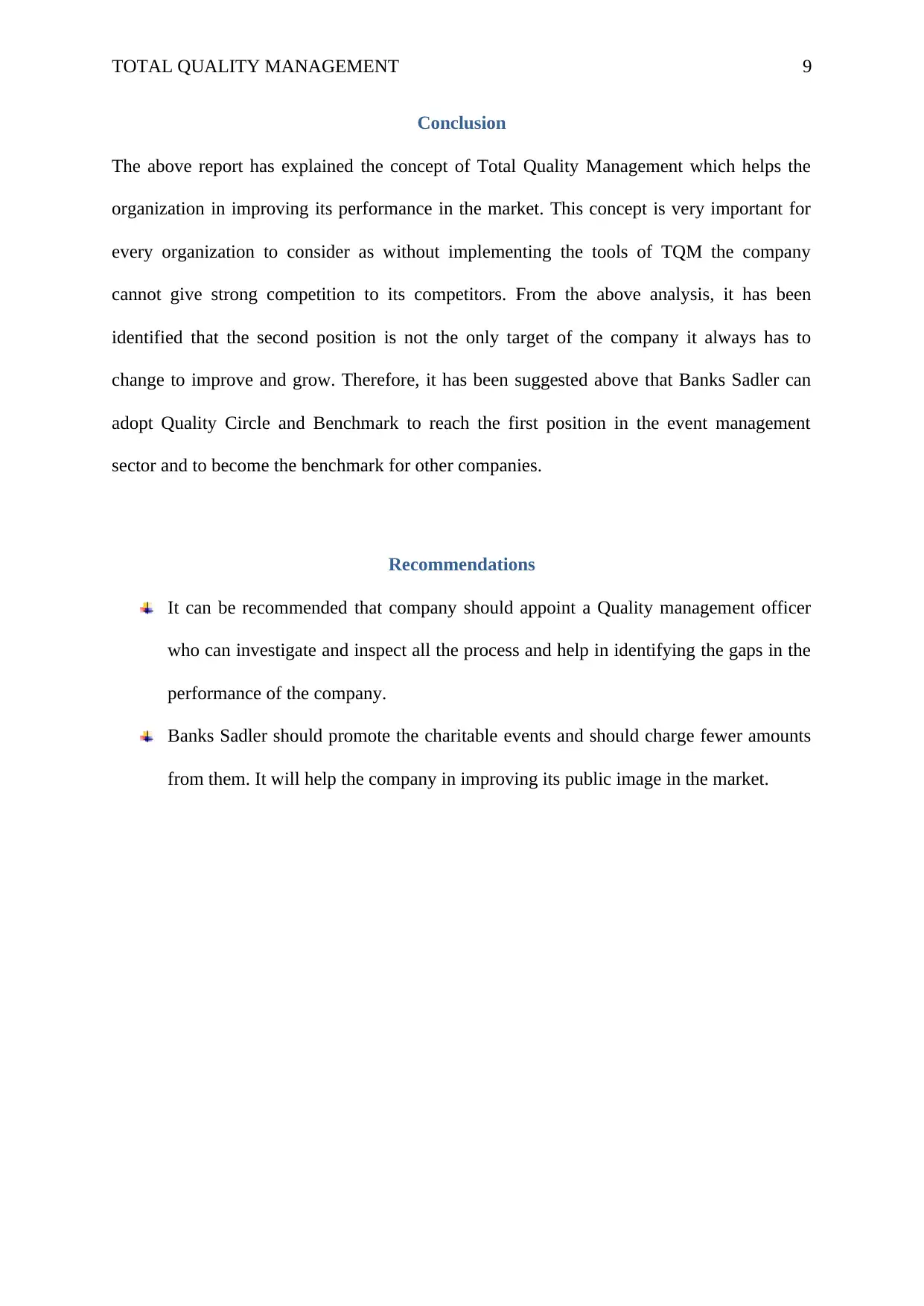
TOTAL QUALITY MANAGEMENT 9
Conclusion
The above report has explained the concept of Total Quality Management which helps the
organization in improving its performance in the market. This concept is very important for
every organization to consider as without implementing the tools of TQM the company
cannot give strong competition to its competitors. From the above analysis, it has been
identified that the second position is not the only target of the company it always has to
change to improve and grow. Therefore, it has been suggested above that Banks Sadler can
adopt Quality Circle and Benchmark to reach the first position in the event management
sector and to become the benchmark for other companies.
Recommendations
It can be recommended that company should appoint a Quality management officer
who can investigate and inspect all the process and help in identifying the gaps in the
performance of the company.
Banks Sadler should promote the charitable events and should charge fewer amounts
from them. It will help the company in improving its public image in the market.
Conclusion
The above report has explained the concept of Total Quality Management which helps the
organization in improving its performance in the market. This concept is very important for
every organization to consider as without implementing the tools of TQM the company
cannot give strong competition to its competitors. From the above analysis, it has been
identified that the second position is not the only target of the company it always has to
change to improve and grow. Therefore, it has been suggested above that Banks Sadler can
adopt Quality Circle and Benchmark to reach the first position in the event management
sector and to become the benchmark for other companies.
Recommendations
It can be recommended that company should appoint a Quality management officer
who can investigate and inspect all the process and help in identifying the gaps in the
performance of the company.
Banks Sadler should promote the charitable events and should charge fewer amounts
from them. It will help the company in improving its public image in the market.
Paraphrase This Document
Need a fresh take? Get an instant paraphrase of this document with our AI Paraphraser
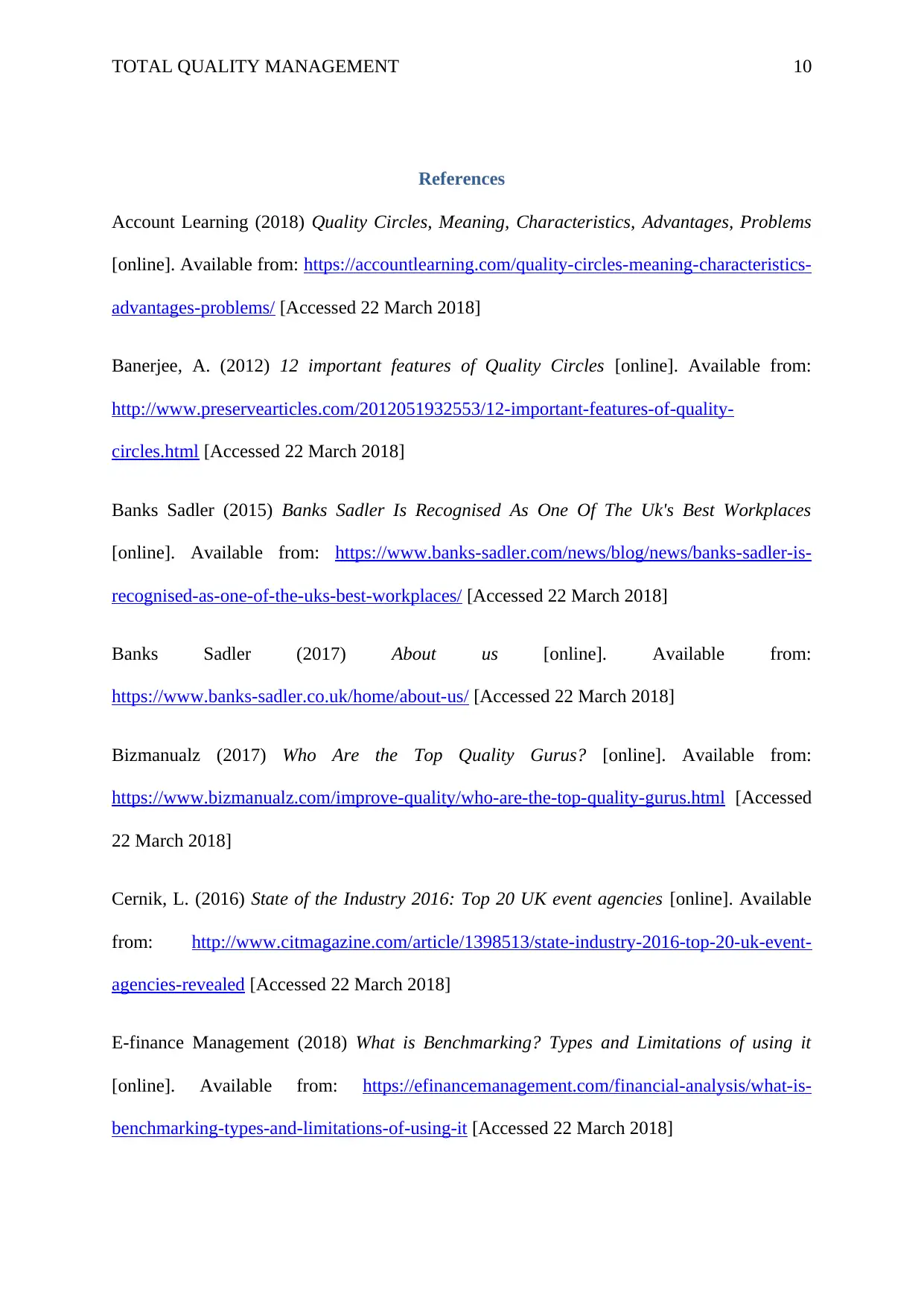
TOTAL QUALITY MANAGEMENT 10
References
Account Learning (2018) Quality Circles, Meaning, Characteristics, Advantages, Problems
[online]. Available from: https://accountlearning.com/quality-circles-meaning-characteristics-
advantages-problems/ [Accessed 22 March 2018]
Banerjee, A. (2012) 12 important features of Quality Circles [online]. Available from:
http://www.preservearticles.com/2012051932553/12-important-features-of-quality-
circles.html [Accessed 22 March 2018]
Banks Sadler (2015) Banks Sadler Is Recognised As One Of The Uk's Best Workplaces
[online]. Available from: https://www.banks-sadler.com/news/blog/news/banks-sadler-is-
recognised-as-one-of-the-uks-best-workplaces/ [Accessed 22 March 2018]
Banks Sadler (2017) About us [online]. Available from:
https://www.banks-sadler.co.uk/home/about-us/ [Accessed 22 March 2018]
Bizmanualz (2017) Who Are the Top Quality Gurus? [online]. Available from:
https://www.bizmanualz.com/improve-quality/who-are-the-top-quality-gurus.html [Accessed
22 March 2018]
Cernik, L. (2016) State of the Industry 2016: Top 20 UK event agencies [online]. Available
from: http://www.citmagazine.com/article/1398513/state-industry-2016-top-20-uk-event-
agencies-revealed [Accessed 22 March 2018]
E-finance Management (2018) What is Benchmarking? Types and Limitations of using it
[online]. Available from: https://efinancemanagement.com/financial-analysis/what-is-
benchmarking-types-and-limitations-of-using-it [Accessed 22 March 2018]
References
Account Learning (2018) Quality Circles, Meaning, Characteristics, Advantages, Problems
[online]. Available from: https://accountlearning.com/quality-circles-meaning-characteristics-
advantages-problems/ [Accessed 22 March 2018]
Banerjee, A. (2012) 12 important features of Quality Circles [online]. Available from:
http://www.preservearticles.com/2012051932553/12-important-features-of-quality-
circles.html [Accessed 22 March 2018]
Banks Sadler (2015) Banks Sadler Is Recognised As One Of The Uk's Best Workplaces
[online]. Available from: https://www.banks-sadler.com/news/blog/news/banks-sadler-is-
recognised-as-one-of-the-uks-best-workplaces/ [Accessed 22 March 2018]
Banks Sadler (2017) About us [online]. Available from:
https://www.banks-sadler.co.uk/home/about-us/ [Accessed 22 March 2018]
Bizmanualz (2017) Who Are the Top Quality Gurus? [online]. Available from:
https://www.bizmanualz.com/improve-quality/who-are-the-top-quality-gurus.html [Accessed
22 March 2018]
Cernik, L. (2016) State of the Industry 2016: Top 20 UK event agencies [online]. Available
from: http://www.citmagazine.com/article/1398513/state-industry-2016-top-20-uk-event-
agencies-revealed [Accessed 22 March 2018]
E-finance Management (2018) What is Benchmarking? Types and Limitations of using it
[online]. Available from: https://efinancemanagement.com/financial-analysis/what-is-
benchmarking-types-and-limitations-of-using-it [Accessed 22 March 2018]
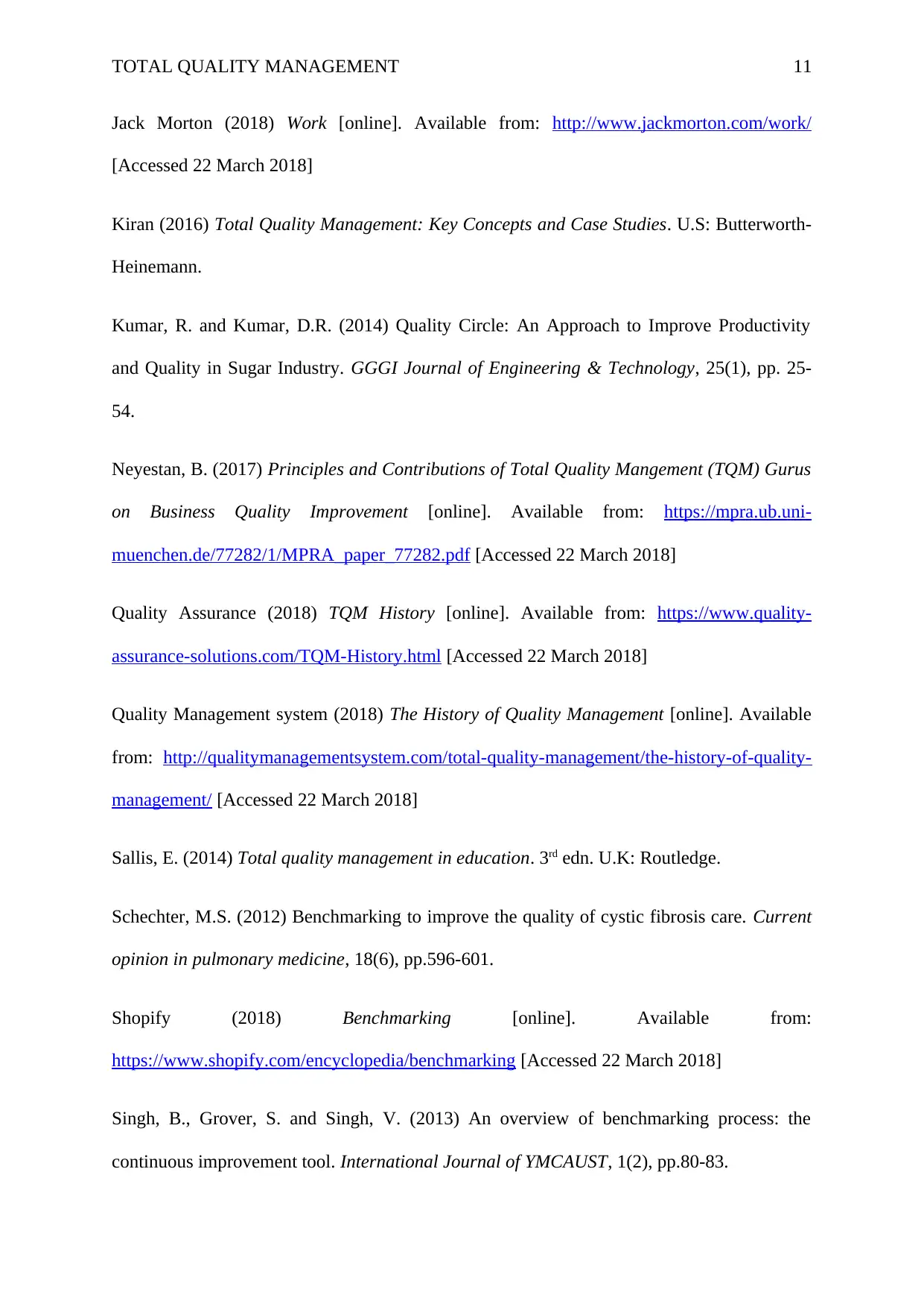
TOTAL QUALITY MANAGEMENT 11
Jack Morton (2018) Work [online]. Available from: http://www.jackmorton.com/work/
[Accessed 22 March 2018]
Kiran (2016) Total Quality Management: Key Concepts and Case Studies. U.S: Butterworth-
Heinemann.
Kumar, R. and Kumar, D.R. (2014) Quality Circle: An Approach to Improve Productivity
and Quality in Sugar Industry. GGGI Journal of Engineering & Technology, 25(1), pp. 25-
54.
Neyestan, B. (2017) Principles and Contributions of Total Quality Mangement (TQM) Gurus
on Business Quality Improvement [online]. Available from: https://mpra.ub.uni-
muenchen.de/77282/1/MPRA_paper_77282.pdf [Accessed 22 March 2018]
Quality Assurance (2018) TQM History [online]. Available from: https://www.quality-
assurance-solutions.com/TQM-History.html [Accessed 22 March 2018]
Quality Management system (2018) The History of Quality Management [online]. Available
from: http://qualitymanagementsystem.com/total-quality-management/the-history-of-quality-
management/ [Accessed 22 March 2018]
Sallis, E. (2014) Total quality management in education. 3rd edn. U.K: Routledge.
Schechter, M.S. (2012) Benchmarking to improve the quality of cystic fibrosis care. Current
opinion in pulmonary medicine, 18(6), pp.596-601.
Shopify (2018) Benchmarking [online]. Available from:
https://www.shopify.com/encyclopedia/benchmarking [Accessed 22 March 2018]
Singh, B., Grover, S. and Singh, V. (2013) An overview of benchmarking process: the
continuous improvement tool. International Journal of YMCAUST, 1(2), pp.80-83.
Jack Morton (2018) Work [online]. Available from: http://www.jackmorton.com/work/
[Accessed 22 March 2018]
Kiran (2016) Total Quality Management: Key Concepts and Case Studies. U.S: Butterworth-
Heinemann.
Kumar, R. and Kumar, D.R. (2014) Quality Circle: An Approach to Improve Productivity
and Quality in Sugar Industry. GGGI Journal of Engineering & Technology, 25(1), pp. 25-
54.
Neyestan, B. (2017) Principles and Contributions of Total Quality Mangement (TQM) Gurus
on Business Quality Improvement [online]. Available from: https://mpra.ub.uni-
muenchen.de/77282/1/MPRA_paper_77282.pdf [Accessed 22 March 2018]
Quality Assurance (2018) TQM History [online]. Available from: https://www.quality-
assurance-solutions.com/TQM-History.html [Accessed 22 March 2018]
Quality Management system (2018) The History of Quality Management [online]. Available
from: http://qualitymanagementsystem.com/total-quality-management/the-history-of-quality-
management/ [Accessed 22 March 2018]
Sallis, E. (2014) Total quality management in education. 3rd edn. U.K: Routledge.
Schechter, M.S. (2012) Benchmarking to improve the quality of cystic fibrosis care. Current
opinion in pulmonary medicine, 18(6), pp.596-601.
Shopify (2018) Benchmarking [online]. Available from:
https://www.shopify.com/encyclopedia/benchmarking [Accessed 22 March 2018]
Singh, B., Grover, S. and Singh, V. (2013) An overview of benchmarking process: the
continuous improvement tool. International Journal of YMCAUST, 1(2), pp.80-83.
⊘ This is a preview!⊘
Do you want full access?
Subscribe today to unlock all pages.

Trusted by 1+ million students worldwide
1 out of 13
Related Documents
Your All-in-One AI-Powered Toolkit for Academic Success.
+13062052269
info@desklib.com
Available 24*7 on WhatsApp / Email
![[object Object]](/_next/static/media/star-bottom.7253800d.svg)
Unlock your academic potential
Copyright © 2020–2025 A2Z Services. All Rights Reserved. Developed and managed by ZUCOL.




